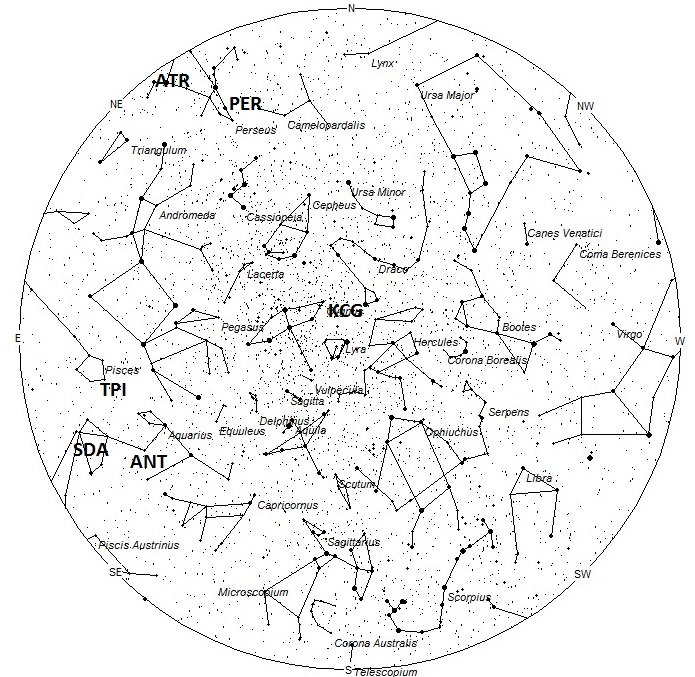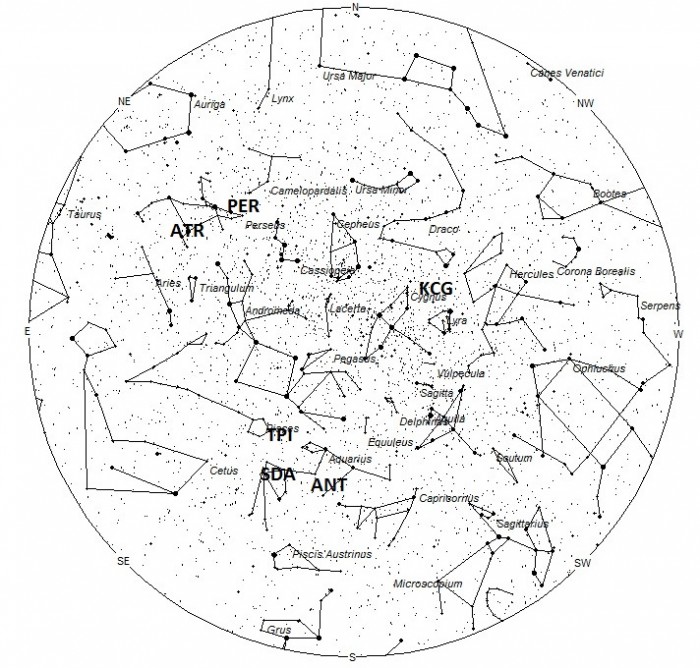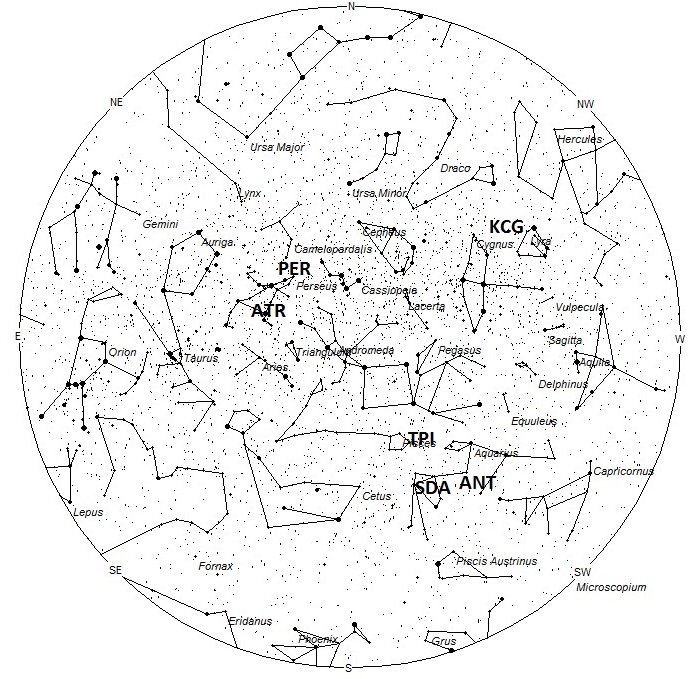During this period the moon reaches its first quarter phase on Tuesday August 13th. At this time the moon is located ninety degrees east of the sun and will set between 2300 and midnight for locations in mid-northern latitudes. This weekend the waxing crescent moon will not interfere with observing as it is very thin and will set shortly after dusk and will not interfere with observing during the more active morning hours. The estimated total hourly meteor rates for evening observers this week is near five for observers located in the northern hemisphere and three for those viewing south of the equator. For morning observers the estimated total hourly rates should be near sixty as seen from mid-northern latitudes and near thirty for observers viewing from tropical southern latitudes. The actual rates will also depend on factors such as personal light and motion perception, local weather conditions, alertness and experience in watching meteor activity. Note that the hourly rates listed below are estimates as viewed from dark sky sites away from urban light sources. Observers viewing from urban areas will see less activity as only the brightest meteors will be visible from such locations.
The radiant (the area of the sky where meteors appear to shoot from) positions and rates listed below are exact for Saturday night/Sunday morning August 10/11. These positions do not change greatly day to day so the listed coordinates may be used during this entire period. Most star atlases (available at science stores and planetariums) will provide maps with grid lines of the celestial coordinates so that you may find out exactly where these positions are located in the sky. A planisphere or computer planetarium program is also useful in showing the sky at any time of night on any date of the year. Activity from each radiant is best seen when it is positioned highest in the sky, either due north or south along the meridian, depending on your latitude. It must be remembered that meteor activity is rarely seen at the radiant position. Rather they shoot outwards from the radiant so it is best to center your field of view so that the radiant lies at the edge and not the center. Viewing there will allow you to easily trace the path of each meteor back to the radiant (if it is a shower member) or in another direction if it is a sporadic. Meteor activity is not seen from radiants that are located below the horizon. The positions below are listed in a west to east manner in order of right ascension (celestial longitude). The positions listed first are located further west therefore are accessible earlier in the night while those listed further down the list rise later in the night.
The following sources of meteoric activity are expected to be active this week:
The Kappa Cygnids (KCG) are weakly active during this period from a wide radiant located at 18:56 (284) +49. This location actually lies in extreme southeastern Draco, five degrees southwest of the dim star Kappa Cygni. Maximum activity is predicted to occur on August 18th so current rates would be less than one per hour no matter your location. With an entry velocity of 23 km/sec. most of these meteors will appear to travel slower than average. The radiant is best placed near 2300 LDT (11pm LDT) when it lies nearly overhead for much of the Northern Hemisphere. Due to its high northern declination this activity is not well seen from the southern hemisphere. Despite the low rates seen from this source, this shower is known to be a producer of fireball class meteors.
The center of the large Anthelion (ANT) radiant is currently located at 22:04 (331) -10. This position lies in central Aquarius, three degrees southwest of the faint star known as Theta Aquarii. Due to the large, oval-shaped radiant, activity from this source may also be seen coming from eastern Capricornus, southwestern Pegasus, and western Pisces as well as Aquarius. These meteors may be seen all night long but the radiant is best placed near 0200 LDT when it lies on the meridian and is located highest in the sky. Rates at this time should be near two per hour regardless of your location . With an entry velocity of 30 km/sec., the average Anthelion meteor would be of slow velocity.
A new source found by IMO video cameras to be active this time of year are the Theta Piscids (TPI). These meteors are active from August 8 through September 1, with maximum activity occurring on August 10. The radiant is currently located at 23:00 (345) -01. This position lies in extreme western Pisces, just west of the faint circle of stars known as the “Circlet”. Hourly rates will be low, most likely less than one per hour no matter your location. These meteors are best seen near 0200 when the radiant lies highest above the horizon. With an entry velocity of 41 km/sec., most activity from this radiant would be of average velocities.
The Delta Aquariids (SDA) reached maximum activity on July 30th. The radiant is currently located at 23:28 (352) -13. This position is located in southeastern Aquarius, five degrees northeast of the third magnitude star known as Skat (Delta Aquarii). Hourly rates will depend on your latitude and time of night. The radiant culminates near 0300 LDT. At this time hourly rates should range from three shower members as seen from the mid-southern hemisphere to near one as seen from mid-northern latitudes. With an entry velocity of 42 km/sec., most activity from this radiant would be of average velocities.
The Eta Eridanids (ERI) are a newly found shower best seen from July 31 through August 17 with maximum activity occurring on August 4th. Weak activity may be seen this week with a radiant located at 02:56 (044) -11. This area of the sky is situated in western Eridanus, only two degrees south of the fourth magnitude star known Azha (Eta Eridani). This area of the sky does not rise until 0200 LDT and is located highest in a dark sky during the last hour before dawn. Rates are expect to be near one per hour no matter your location. With an entry velocity of 66 km/sec., the average Eta Eridanid meteor would be swift.
The Perseids (PER) reach maximum activity on August 12 from a radiant located at 03:12 (048) +58. This position lies where the borders of Perseus, Cassiopeia, and Camelopardlis meet. The nearest star of note would be third magnitude Gamma Persei, which lies four degrees south of the radiant. The radiant is best placed during the last hour before the start of morning twilight when it lies highest in a dark sky. Predawn rates this weekend would be near forty as seen from mid-northern latitudes and ten as seen from south tropical latitudes. Activity from this source is not visible south of 40 degrees south latitude. With an entry velocity of 61 km/sec., most activity from this radiant would be swift.
Another new source found by IMO video cameras to be active this time of year are the Alpha Triangulids (ATR). This radiant has recently been found to be active later than previously published, with the activity period ranging from July 25 through August 20 with maximum activity occurring on July 27. Current rates would be less than one per hour no matter your location. The radiant is currently located at 03:12 (048) +40, which is actually situated in southeastern Perseus, very close to the famous naked eye eclipsing binary star known as Algol (Beta Persei). The radiant is best placed during the last hour before dawn, when it lies highest in a dark sky. With an entry velocity of 68 km/sec., the average Alpha Triangulid meteor would be swift. Meteors from this radiant may be associated with a defunct shower known as the Beta Perseids.
As seen from the mid-northern hemisphere (45N) one would expect to see approximately fourteen sporadic meteors per hour during the last hour before dawn as seen from rural observing sites. Evening rates would be near four per hour. As seen from the tropical southern latitudes (25S), morning rates would also be near seven per hour as seen from rural observing sites and two per hour during the evening hours. Locations between these two extremes would see activity between the listed figures.
The table below presents a list of radiants that are expected to be active this week. Rates and positions are exact for Saturday night/Sunday morning unless indicated in the verbal description of each shower.
| SHOWER | DATE OF MAXIMUM ACTIVITY | CELESTIAL POSITION | ENTRY VELOCITY | CULMINATION | HOURLY RATE | CLASS |
| RA (RA in Deg.) DEC | Km/Sec | Local Daylight Time | North-South | |||
| Kappa Cygnids (KCG) | Aug 18 | 18:56 (284) +49 | 23 | 23:00 | <1 – <1 | II |
| Anthelions (ANT) | – | 22:04 (331) -10 | 30 | 01:00 | 2 – 2 | II |
| Theta Piscids (TPI) | Aug 20 | 23:00 (345) -01 | 41 | 02:00 | <1 – <1 | II |
| Delta Aquariids (SDA) | Jul 30 | 23:28 (352) -13 | 42 | 03:00 | 1 – 3 | I |
| Eta Eridanids (ERI) | Aug 04 | 02:56 (044) -11 | 66 | 06:00 | 1 – 1 | IV |
| Perseids (PER) | Aug 12 | 03:12 (048) +58 | 61 | 06:00 | 40 – 10 | I |
| Alpha Triangulids (ATR) | Jul 27 | 03:12 (048) +40 | 68 | 06:00 | <1 – <1 | IV |
 American Meteor Society
American Meteor Society


